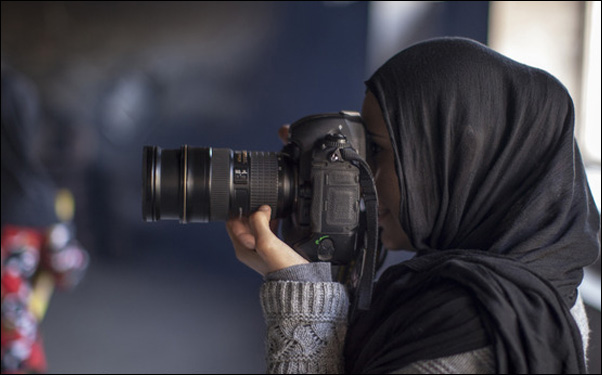Among the typical needs that can be found in the Kickstarter campaign for Alexandria Bombach and Mo Scarpelli’s documentary “Frame by Frame” such as lodging and equipment, on particular line item in the budget stands out — a fixer.
“It’s expensive to shoot in Afghanistan because you have to pay somebody to basically be with you all the time,” says Scarpelli, a Brooklyn-based filmmaker who plans to return to the country with Bombach this fall should the film reach its crowdsourcing goal by August 28th. “The fixer is very important because [he] has his ear to the ground and get texts and calls from all the other local Afghans and find out what areas have sort of a red alert that day. It’s essential for us to get our job done.”
Of course, the necessity of such security reinforces why Scarpelli and Bombach believe it’s so important to make “Frame By Frame,” a film that will follow four Afghan photojournalists as they embark on what is a relatively new profession in the country, since photography was prohibited during the era of Taliban rule. While one of the film’s subjects, Najibullah Musafer, was one of the few, if any who managed to do so, he has been joined by others since the former regime was toppled, giving way to a group of diverse perspectives in the region where the spread of information had previously been stifled.
“There was not a free press at all in Afghanistan prior to 2001 and when the troops came in and the Taliban was ousted from Kabul, it opened up this vacuum in which people actually have the opportunity to pursue journalism,” says Scarpelli. “It coincided for these photographers with the digital revolution as well. The internet was blowing up in 2001 in Afghanistan and around the world and photography was easier in digital form, so all this culminated to make a really unique situation.”
With that in mind, Scarpelli and Bombach, who are both veterans of social justice-themed filmmaking, were drawn to the region to capture that story in a short, so convinced of its worth that Bombach sold her car to fund the production. But after conducting many interviews during their initial trip in the fall of 2012, they discovered they were on to something even bigger than expected.
In addition to Musafer, the pair had found three other compelling subjects in Farzana Wahidy, the first female photographer from the country to work with international outlets such as Agence France-Presse, Wakil Kohsar, a native of the Panjshir Valley who came back to the country after fleeing with his family to Pakistan and now works for the groundbreaking news organization Tolo TV, and Massoud Hossaini, who became the 2012 winner of the Pulitzer Prize for breaking news photography when he snapped a picture of the aftermath of a suicide bombing for Agence France-Presse.
“From the very beginning when we were going to do a short story, we were very driven to tell the story of local photographers in Afghanistan,” says Scarpetti. “What’s that like trying to build your field in your own media really as your own free press? What is it like to be doing that with a flurry of foreigners around you telling you and influencing you on that and then what’s it going to be like when they all leave?”
Scarpelli and Bombach intend to find out, though with the larger canvas of a feature, they also are hoping to paint a portrait of each of the photographers as rich as the pictures they take, something that would only be possible with additional time afforded by a successful Kickstarter campaign.
“We followed each of the photographers around a little bit in their personal work, but we did not get the chance to really follow their interactions with the people they’re shooting and with the issues and stories they’re covering,” says Scarpelli, who envisions completing principal photography by the end of the year, if all goes according to plan. “We’re really, really excited [about the possibility] to go back and spend enough time with them to become a fly on the wall [where] they don’t even know we’re there anymore and they’re just shooting or talking about things in the way they normally would.”
Of course, that is likely the only aspect of “Frame By Frame” which could be considered ordinary, a rare and likely unique look at a country that is in the midst of reshaping its own image.
To back this project and watch the filmmakers’ personal pitch video, click here. And follow the film’s progress on Facebook, its official site, and its Tumblr.




